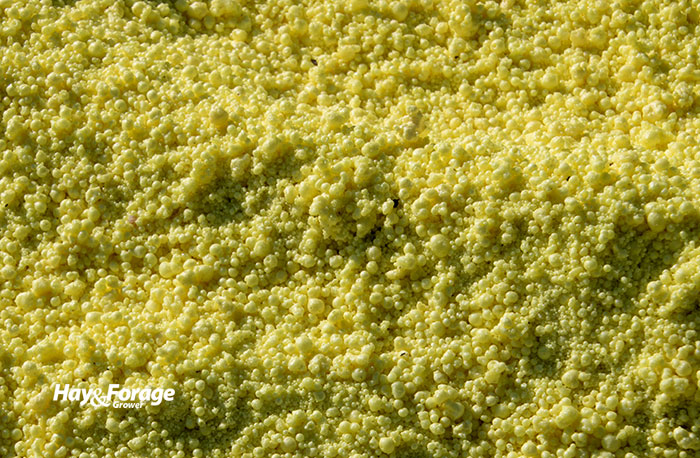
Sulfur is a key component of many plant compounds and processes. The nutrient is found in two amino acids that are used for protein synthesis, and it is critical for chlorophyll production.
Dan Lima with Ohio State University Extension says legumes require additional sulfur for nitrogen fixation. For this reason, legumes are particularly sensitive to sulfur deficiency, especially alfalfa, which is notably a heavy sulfur-using crop.
Signs of sulfur deficiency include young leaves that are light green or yellow due to reduced protein and chlorophyll content. Sulfur is a secondary macronutrient because it is required at lower levels than the primary macronutrients nitrogen, phosphorus, and potassium; however, this does not mean it is any less essential to plants or the livestock that consume them.
“Remember that all life requires sulfur, so if the dried forage is deficient, animals could also be deficient,” Lima asserts.
Deficiencies can be detected through soil and forage tissue samples. Many labs have established the critical level of sulfur in soil as 15 parts per million (ppm). Since this is a relatively low concentration, forage tissue sampling is often considered the more accurate testing method. Lima notes an adequate concentration of sulfur in plant leaves is between 0.2% and 0.5%.
Amendment options
If soil test results indicate a field is deficient, Lima suggests adjusting soil pH and addressing nitrogen, phosphorus, and potassium needs prior to adding sulfur. Then, use a forage tissue sample to determine how much sulfur to apply and choose a fertilizer source.
Lima notes that soils in the eastern part of his state of Ohio historically had high levels of sulfur from coal energy production. In fact, acid rain from industrial pollution used to supply sulfur to soil in many parts of the country before the Clean Air Act was enacted in the 1970s. Now, commercial sulfur or manure must be applied.
Elemental sulfur can take several months to react because it needs to be oxidized by soil microbes before it can be taken up by plants. Sulfate, on the other hand, is readily available to forage. Lima says ammonium sulfate and gypsum are two common fertilizer options, especially in soils with higher amounts of organic matter.
Applying manure is a more cost-effective way to correct sulfur deficiencies, and Lima notes it will also provide various micronutrients to the soil. He adds that manure is rich in organic sulfur, which can be converted to sulfate by soil microbes.
“If manure is not available, it is almost twice the cost to fertilize a field with sulfur using ammonium sulfate,” Lima states. “At this price, a forage analysis would make sense before making such a large investment. Furthermore, ammonium sulfate is not always available at your local co-op and would take an even greater effort to obtain.”
No matter the source, ensuring sulfur levels are in check will promote a more robust stand of healthier forage. Sulfur’s role in protein synthesis, photosynthesis, and nitrogen fixation is too important to overlook with improper fertilization.

